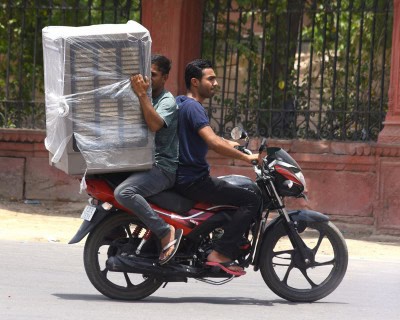New Delhi, Oct 29 : Improving rural prospects, downtrading in a subdued income environment, and greater preference for personal mobility will support sales of motorcycles in the economy segment (53 per cent of sector volume last fiscal), thereby limiting the slide in overall two-wheeler sales to 15-17 per cent(s) this fiscal, Crisil Ratings said on Thursday.
As per a CRISIL study of 5 manufacturers, accounting for 80 per cent of the sector’s sale volume, better prospects of the agriculture sector in the cropping seasons would ensure higher disposable income in rural India that would boost two-wheeler sales, largely in economy segment, and will also drive up the segment’s share by 300 bps to 56 per cent of the overall pie.
Hinterland, which accounts for half of two-wheelers sold, saw good traction in the kharif (summer) sowing season supported by a good and evenly spread monsoon. With water reservoirs also at healthy levels of 87 per cent on average, the tidings are good for the rabi (winter) crop, too. As a result, agriculture GDP is seen growing 2.5 per cent even as India’s GDP is estimated to contract 9 per cent in the current fiscal.
Additionally, hike in the minimum support price (MSP) for key crops will also boost rural income and discretionary spending.
Hence, rural demand for two-wheelers is seen recovering faster, with sales estimated to grow 500 basis points (bps) more than urban, where income growth is more tepid.
This is underscored by data on rural two-wheeler retail registrations during April-September 2020.
The economy motorcycle segment generates 75 per cent of sales from the rural market, and should benefit the most, given the milieu. Furthermore, price hikes of 10-12 per cent to comply with BS VI emission norms have increased the pricing gap between economy motorcycles and other segments, which is driving up preference for the former.
While the Covid induced lockdown has been lifted across the country, public transport remains somewhat restricted. With sharper focus on social distancing, preference for personal mobility is rising. This in turn is benefitting motorcycle demand, especially the economy segment.
Gautam Shahi, Director, CRISIL Ratings, said: “Due to these reasons, the economy motorcycle segment is expected to see lower volume contraction of 11-13 per cent compared with 15-17 per cent overall in two-wheeler sales this fiscal.”
Despite decline in overall two-wheeler sales for two consecutive fiscals resulting in multi-year low capacity utilisation, operating margin of players will see only 200-300 bps decline to 12 per cent this fiscal. Cost rationalisation efforts including higher transport by rail, and pruned advertisement spends will help partially offset higher cost BS VI compliant vehicles.
Sushant Sarode, Associate Director, CRISIL Ratings, said: “While the two-wheeler sector has seen few weak business cycles in the past decade, credit quality of manufacturers has largely remained unaffected due to strong balance sheets, limited debt, negative working capital cycle, and robust liquidity of players. Ergo, even two consecutive years of weak demand is unlikely to materially impact their credit quality. They also have sizeable cash surpluses (Rs 35,500 crore for the sample set), to help mitigate cash flow challenges.”
A reduction in GST rates, even if temporary, would come as a tailwind to sales across segments. And any further increase in Covid-19 afflictions in hinterland, and its socio-economic impact, will be the key monitorable.
Next fiscal, a low base effect along with expectation of improvement in economic activity and gradual waning away of pandemic may spur growth for two wheelers to 10-12 per cent(s).
Disclaimer: This story is auto-generated from IANS service.

